New Book Releases / Winter 2022
If you want to signal a recent or forthcoming film publication for the next round-up in spring, please contact Ruben Demasure. For notes on more books, see David Hudson’s monthly roundup at Criterion’s The Daily.
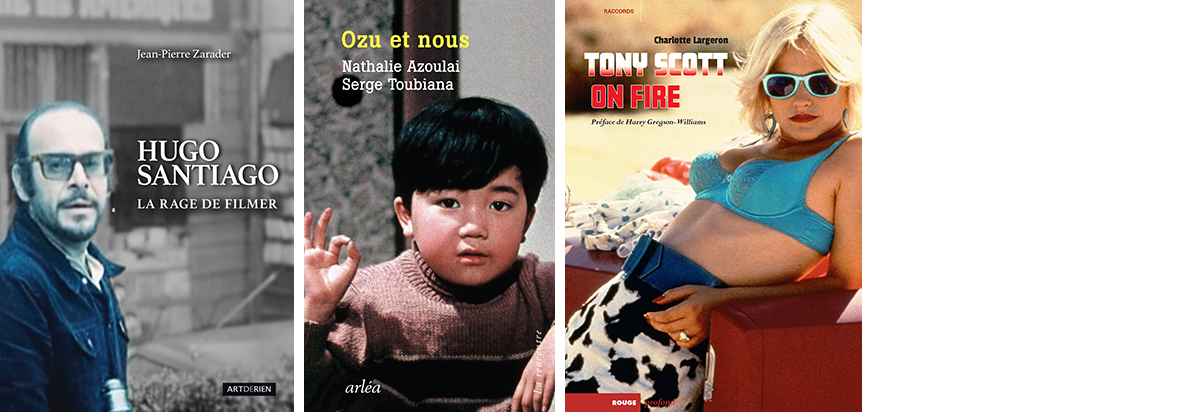
Let’s start off with an odd threesome: Hugo Santiago, Yasujiro Ozu and Tony Scott – three filmmakers who have recently been honored with a personal auteur study. In Hugo Santiago: La rage de filmer, the French philosopher Jean-Pierre Zarader explores the work of the France-based Argentine director, who’s been a pupil of Borges and assistant to Bresson. Zarader argues that all of his films – such as Invasión (1969), Les autres (1974) or Écoute voir (1979) – mainly ask one question: what is cinema? This book-length essay was put out last October by the young publishing house, open to artistic experimentation, Éditions Artderien.
At the origin of Ozu et nous lies a shared fascination for the work of this major Japanese filmmaker. Former chief of Cahiers and of the Cinémathèque française, Serge Toubiana, and Prix Médicis-winning author Nathalie Azoulai started to write to each other, film after film, together marveling at the mysteries held by all these family stories and gradually ‘tamed’ what is strange and familiar between Ozu and us. Published last October with Arléa, this pocketbook doesn’t approach the films in a strictly chronological or historical manner, but almost as intimate, living household objects as critic Thierry Jousse writes.
Tony Scott on Fire explores the director of Top Gun (1986), Déjà Vu (2006) and Unstoppable (2010) as a plastic artist who has never ceased to strive for a refined research on form, purified his aesthetic preferences to achieve an essentially sensitive cinema and made our contemporary world a mechanical machine which his protagonists must confront through action. Embracing his entire filmography, the book is out with Éditions Rouge Profond since September.

One of Tony Scott’s films might very well be included in For Promotional Use Only, a coffee table book by A24 chronicling over 160 artifacts of zany Hollywood marketing excess and ingenuity, such as a Twister (1996) necktie, a Bean (1997) mousepad or a The Notebook (2004) bucket hat. Roger Corman, ‘The Pope of Pop Cinema’, has written the foreword. Another playful approach can be found in Louise Deschamps’ minimalist and stylized illustrations for ABC Tati, out with Éditions Hélium. For each letter, a word and an image evoke a scene, a gag or a key element of Jacques Tati’s filmography.
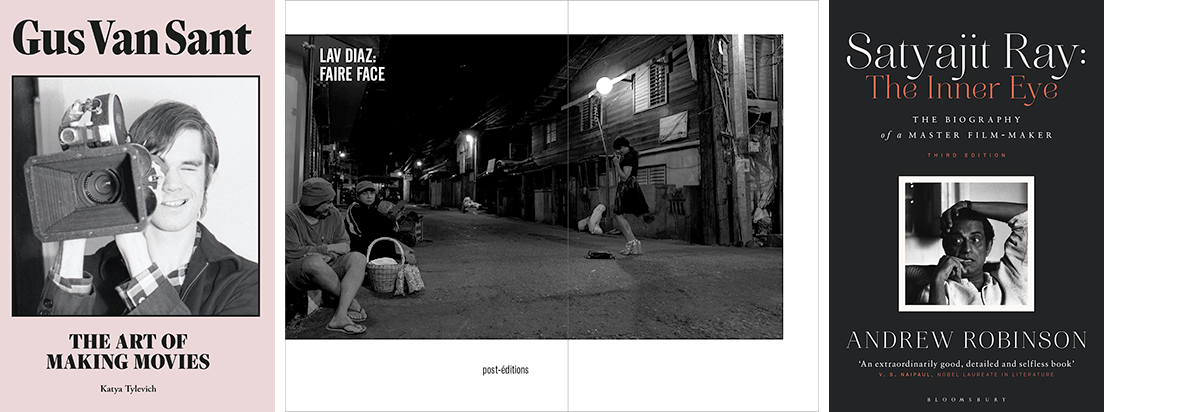
The next trio of books largely consists of conversations with filmmakers. Published with Laurence King by art writer Katya Tylevichn, Gus Van Sant: The Art of Making Movies is based on a series of completely new and exclusive interviews. Van Sant not only reflects on nearly four decades of filmmaking, but also on his artistic output as a painter and photographer. On AnotherMag, you can read an interview with Van Sant about the new book that’s available since October. Forthcoming with Post-Éditions next January, the richly illustrated Lav Diaz: Faire face also includes never before published interviews with the Filipino filmmaker, as well as contributions by several film critics on his cinema. The third title, based on extensive interviews with the director himself, his actors and collaborators, is Andrew Robinson’s biography of Satyajit Ray. Originally published in 1989, The Inner Eye is now out in a third expanded edition with Bloomsbury. Added to the previous edition of 2003 are an epilogue, a conversation with Ray and an updated comprehensive bibliography of Ray's writings.

Since our last book note, we are again treated to several new Harun Farocki publications. Two of them will be out in the new year; two others, both published by the Harun Farocki Institut, are already available. Volume 5 in the latter’s ‘Writings’ series, Harun Farocki. Unregelmäßig, nicht regellos. Texte 1986–2000 collects texts that Farocki wrote to accompany and comment on groundbreaking films such as Images of the World and the Inscription of War (1989) and Videograms of a Revolution (1992). An essay by editor Tom Holert rounds off this volume. Meanwhile, the fourteenth installment of the HaFi series, Harun Farocki: Hard Selling – Reframed by Elske Rosenfeld, publishes a typescript and archival materials related to Farocki’s television film Hard Selling (1991). For this unfinished project, Farocki documented an Adidas sales training in East Berlin in 1990, exploring the operational details of introducing the logic of the free market in a country formerly trained in planned economy. The artist Elske Rosenfeld follows and reframes the film stills, fragments of conversations and announcement texts of this tv project.
Farocki was not able to complete his autobiography; he died in July 2014. In fall 2022, Archive Books will present the English translation of the autobiography which had been published posthumously in German in 2017 by Walter König. Take a sneak peek here: Ten, Twenty, Thirty, Forty – Fragment of an autobiography: Writings, Volume 1. Only a few weeks prior to his untimely death, Harun Farocki briefly referred to navigation as a contemporary challenge to montage – editing distinct sections of film into a continuous sequence – as the dominant paradigm of techno-political visuality. Navigation Beyond Vision focuses on the question: How does the shift from montage to navigation alter the way images – and art – operate as models of political action and modes of political intervention? Published by Sternberg Press & E-flux Journal in March 2022, the book will include contributions by Hito Steyerl, Anselm Franke and James Bridle, among others.
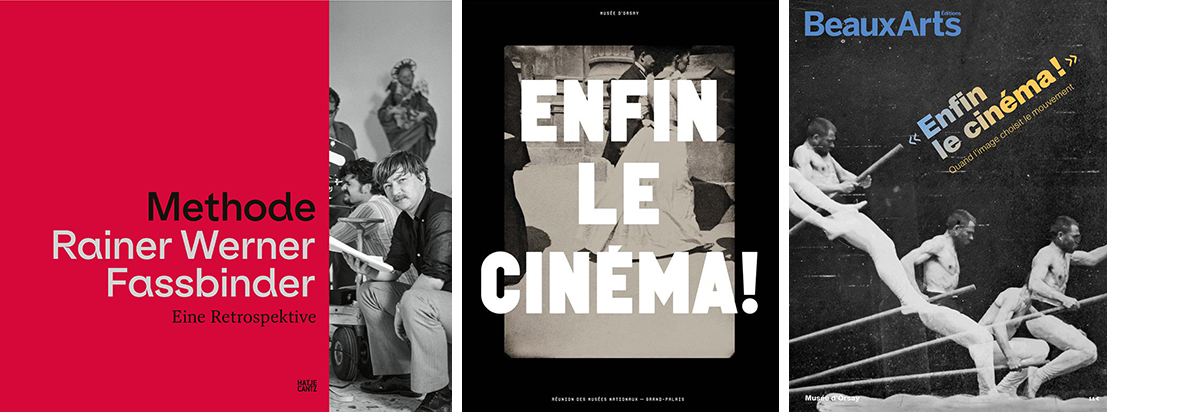
This fall saw the publication of two notable exhibition catalogues. Methode Rainer Werner Fassbinder: Eine Retrospective accompanies the extensive Fassbinder exhibition that runs until March 6, 2022 at the Bundeskunsthalle in Bonn. Published by Hatje Canz, this German-language catalogue contains contributions by film historians, critics and filmmakers such as Michael Töteberg and Wim Wenders and offers a comprehensive analysis of Fassbinder’s oeuvre.
Enfin le cinéma !, the catalogue of the eponymous exhibition that is currently on show at Musée d’Orsay in Paris until January 16, goes back to the origins of cinema in France. With a focus on the period between 1895 and 1907, curator and editor Dominique Païni looks at the invention of the moving image through the history of the arts. By situating the emergence of cinematographic production in its cultural and artistic context, both the exhibition and the catalogue confirm Jean-Luc Godard’s famous expression that cinema was invented by the 19th century. Beaux-Arts also dedicated a special issue of their ‘hors-série’ to the exhibition.
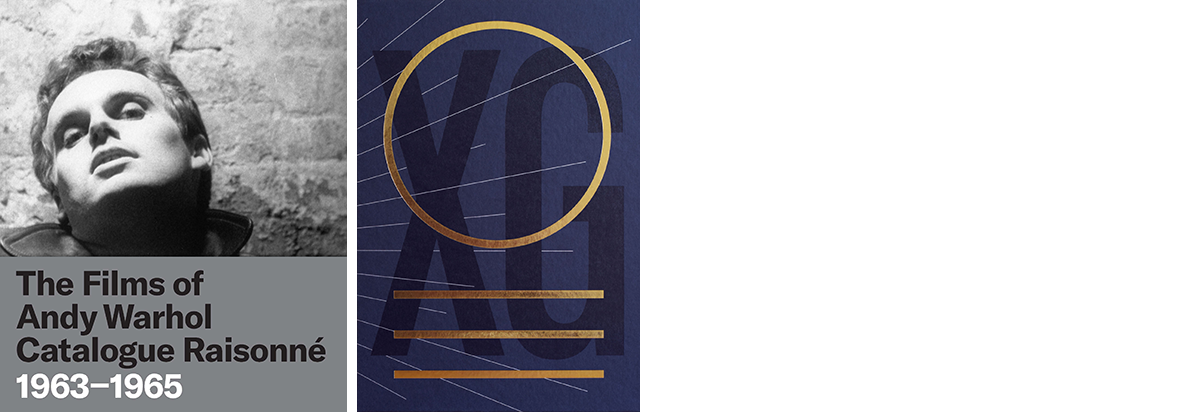
Next up are two special catalogues raisonnés. Published by the Whitney Museum of American Art, The Films of Andy Warhol – Catalogue Raisonne: 1963-1965 is a vigorously researched and extensively illustrated collection of Warhol’s abundant film work in the mid-sixties. It collects essays and entries by Elena Gorfinkel and Bruce Jenkins, among others, examining and documenting the broad and detailed context in which the artist worked: from his influences to how he interacted with the ones he filmed. This second volume is a complement to the 2006 first tome of the catalogue raisonné on Warhol’s ‘Screen Tests’ – the hundreds of three-minute cinematic portraits he made of people like Bob Dylan or Susan Sontag in the early and mid-sixties.
Xenogenesis, on the other hand, is the first catalogue raisonné on the work of The Otolith Group (Anjalika Sagar & Kodwo Eshun). Published by Archive Books and the Irish Museum of Modern Art, it collects their work as it was presented in the Xenogenesis exhibition, supplemented by materials such as archival images, documented conversations, early lecture performances as well as other accompanying texts by Anselm Franke, Fred Moten and the late Mark Fisher, among others.
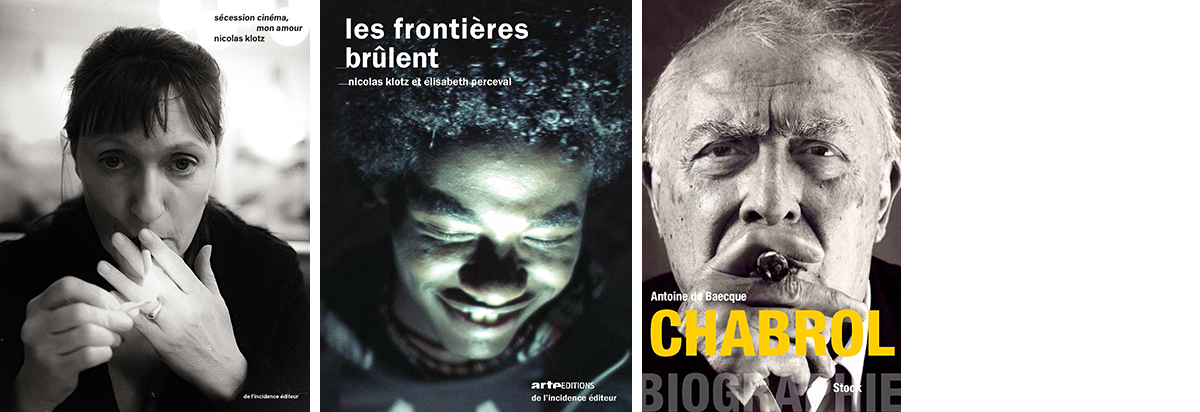
On the occasion of the Nicolas Klotz & Élisabeth Perceval retrospective at the Centre Pompidou in Paris (December 2 – January 2), De L’Incidence Éditeur has published two books on and by the filmmaker couple who made La Blessure (2004), La question humaine (2007) and Low Life (2012), among other more recent work. In Sécession cinéma, mon amour, Nicolas Klotz brought together writings, notes and photographs – fragments as snapshots taken from his fifteen-year archive. In Les frontières brûlent, on the other hand, he and Élisabeth Perceval invited a range of critics, philosophers and filmmakers to all write around and about one area: the jungle of Calais. They also unveil the preparatory work for a film in progress: Chant pour la ville enfouie. Among the contributors are Nicole Brenez, Jean-Luc Nancy, Raphaël Nieuwjaer, Chris Fujiwara, Robert Bonamy, Luc Chessel, Cyril Neyrat and Antoine de Baecque. The latter has also just put out a new biography of the French filmmaker Claude Chabrol last September. You can read a long excerpt of Chabrol on the website of the publisher, Éditions Stock.
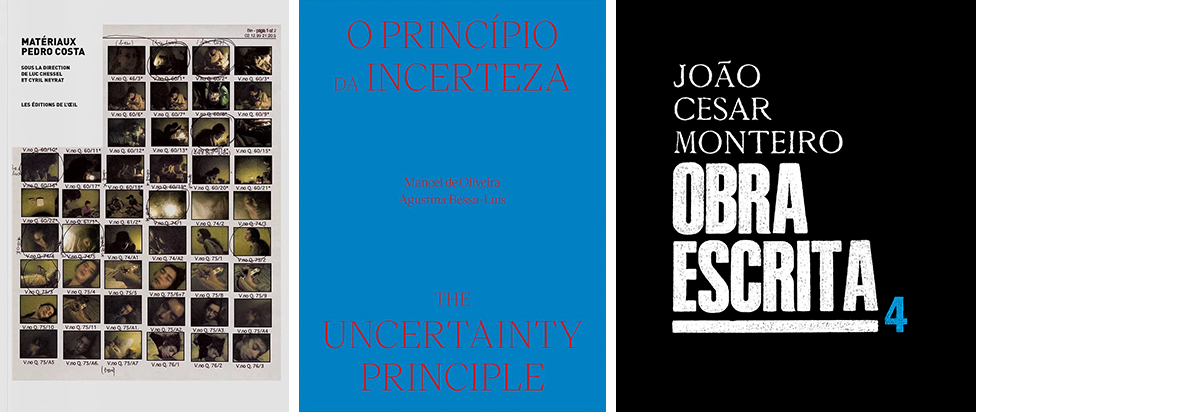
Two of the other contributors above, Luc Chessel & Cyril Neyrat, also compiled Matériaux – Pedro Costa. Out on January 12 but available for pre-order from Éditions de l’Oeil, the book includes documents, letters of Ventura and Vitalina, photograms and set photos. Among the included texts, there’s a French translation of Costa’s piece on Howard Hawks’ Land of the Pharaohs (1955), first published in the Cinemateca Portuguesa’s 1990 Howard Hawks and available on Film Comment in an English translation by Ricardo Matos Cabo & Andy Rector. The latter edited the English version of Patrick Holzapfel’s text on Vitalina Varela as “Expensive Cement” on his own website, and it is now available here in French. Also translated is João Bénard da Costa’s text on Costa, “O negro é uma cor” from Cem mil cigarros: Os filmes de Pedro Costa (Orfeu Negro, 2009) – and from that same book: Jean-Pierre Gorin’s “Nine Notes on Where Does Your Hidden Smile Lie?”, that was reproduced in English in the Austrian Filmmuseum’s 2016 Straub-Huillet book. Included as well are Shigehiko Hasumi’s “Adventure: An essay on Pedro Costa”, available in English on Rouge, and Costa’s own “Three Hours with Professor Hasumi on a Train in Japan”, available in English on LOLA. Bernard Eisenschitz’s “Que raconte ce film(s)?” from Trafic 77 (2011) has been reprinted, and, if we’re not mistaken, there’s an unpublished interview conducted by the editors, a new text by each of them and by Andy Rector.
Another major Portuguese director is the subject of a new publication that also contains some of his working materials. The Uncertainty Principle: Manoel de Oliveira / Agustina Bessa-Luís focuses on eight films by de Oliveira that had the participation of the writer Bessa-Luís or that were based on her own novels. Among the most unique cases of film adaptations of literary texts in the history of cinema, several authors were invited to write about each of them. The bilingual book (PT-EN) also features a selection of correspondence between the two, unpublished documentation and a selection of photographs and stills from the films. Published by the Serralves Foundation, the publication accompanies the homonymous exhibition at the Casa do Cinema Manoel de Oliveira in Serralves (December 1 - June 5).
The collected writings of Portuguese filmmaker João César Monteiro are now at the point of Volume 4 of what was initiated as a work in five parts. Letra Livre, the independent publisher and bookshop in Lisbon, continues to put out the Obra Escrita, which brings together his texts (in the original language) – from film scripts to his film criticism and correspondence. Following the chronology of Monteiro’s films, this tome collects what he has written for As Bodas de Deus (in two versions) (1999) and his final film Vai e Vem (2003). The first volume of Obra Escrita was published in 2014 and included the material written for his first four films, including Silvestre (1981). Volume Two (containing the 1986 À Flor do Mar) and Three followed in 2015 and 2017, respectively.

Next March, Pier Paolo Pasolini’s centenary will be celebrated. In light of this occasion, Gremese Editore publishes Tout sur Pasolini, a book compiled by Hervé Joubert-Laurencin, who previously edited the monumental Écrits complets by André Bazin (Éditions Macula). The publication will have an encyclopedic structure, from the letter A of “Accattone” to the letter Z of “Zanzotto” (with more than 150 “entries” in total), also containing introductory essays. One month later in February, the same publishing house will also release a monograph on Il vangelo secondo Matteo [The Gospel According to St. Matthew] (1964), containing a detailed scene by scene analysis and photograms taken directly from the film strip. More by Joubert-Laurencin can be found at the Belgian publishing house Éditions Yellow Now, where he coordinated and edited De Zéro de conduite à Tomboy. Forthcoming in March, this almost 500-page volume is structured by way of double bills connected to a personal point of view per film based on the archives of “Les enfants de cinéma”, an association for the artistic education of children through imagery. Pasolini’s work was a point of focus this year as well in the two-volume collection of booklets, Politique de l’auteur, collectively issued in February and May 2021, respectively, by the editors and authors behind publishing house La Nerthe. Jacques Sicard, a contributor to both parts, has in recent years authored several original publications on Chris Marker, Jean-Luc Godard and Yasujiro Ozu.
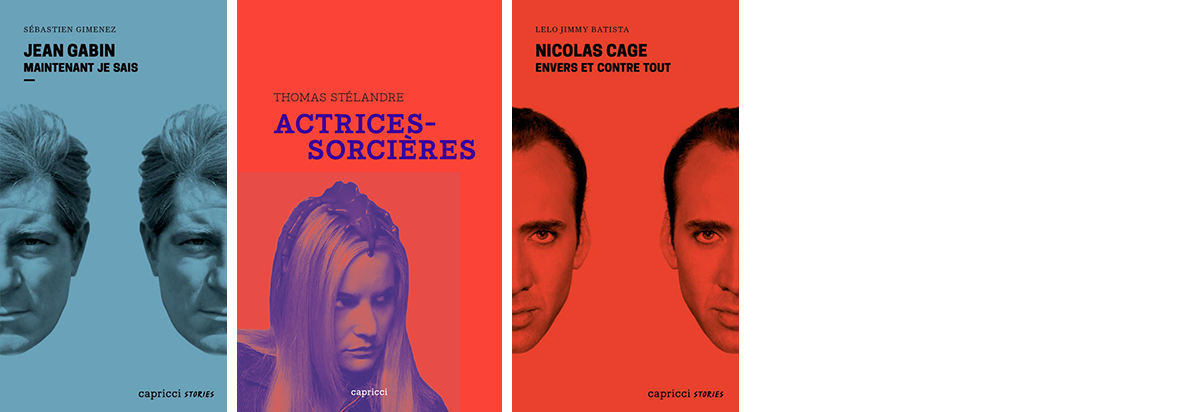
The crop of the always prolific publishing house Capricci is this time devoted to a diverse range of actors and actresses. Jean Gabin: Maintenant je sais sets out to discover the man behind the vedette, an actor who loved nothing more than being silent and whose real name was in fact Jean Moncorgé. Actrices-sorcières, the only Capricci title not yet available as of November but released next January, takes a feminist, cinephile and literary look at ‘witch-actresses’ (Asia Argento, Béatrice Dalle, Twin Peaks’s Sheryl Lee, Jennifer Jason Leigh, Jeanne Moreau, Tilda Swinton, …). The book tells of the different trajectories of women who, in films and in life, have been something other than “sleeping princesses”. The actor who famously meets the good witch at the end of David Lynch’s Wild at Heart (1990) is at the center of Nicolas Cage: Envers et contre tout. Subject to an endless collection of memes and a specific type of cult following, the versatile Cage is followed here along a trail using diverse manifestations such as the horse, dragon, pony and raven.
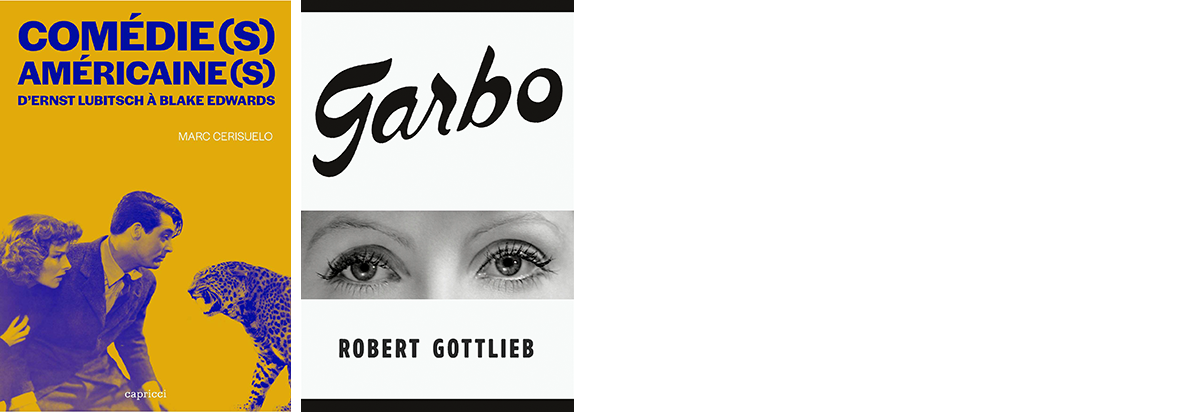
Nicolas Cage is too young to be part of the many actors one comes across in the last new Capricci volume, Comédie(s) Américaine(s): d'Ernst Lubitsch à Blake Edwards. Edited by specialist Marc Cerisuelo, the book is an exploration of the diverse genre of comedy in American cinema, roughly between 1918 and 1968. The star of Ernst Lubitsch’s Ninotschka (1939) – “Garbo Laughs!” – is also the subject of a new book of her own. In Garbo, the acclaimed literary editor, dance and literature critic, and former editor-in-chief of The New Yorker, Robert Gottlieb offers a rich account of her life, concluded by a 100-page “Garbo Reader” that assembles glimpses of Garbo from other people’s memoirs and interviews (Ingmar Bergman, Roland Barthes, Ernest Hemingway, Graham Greene, …), or songs and cartoons. 250 stills, portraits or snapshots are reproduced in duotone.
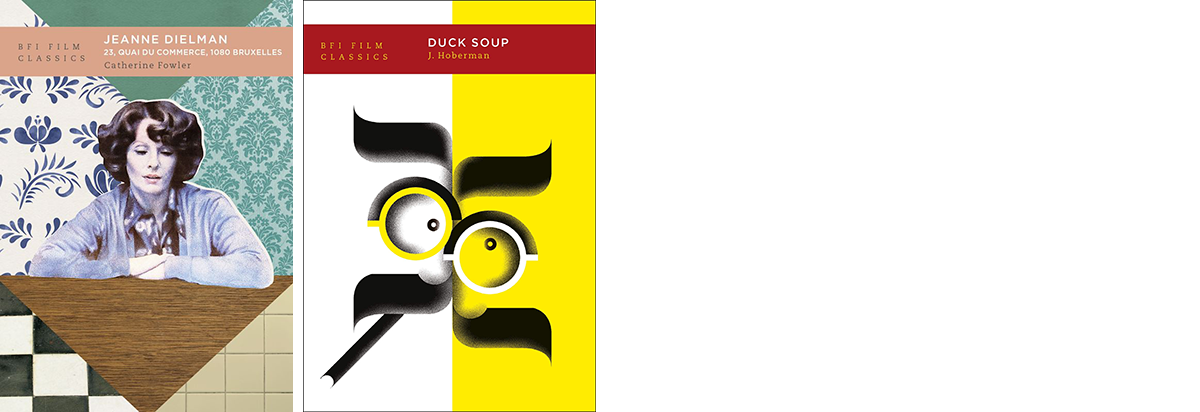
Moving over to a cluster of recent monographs on one film, there’s a terrific batch of new titles in the BFI Classics Series. Akerman expert Catherine Fowler positions Jeanne Dielman (1975) as a ‘contrary’ classic. She draws on original footage, scripts, unmade and unseen projects, interviews and other documents to piece together the making of the film, discovering an alternative origin story which centers upon female alliances, forged through a combination of shared film culture and lived sexism. In Duck Soup, J. Hoberman's analysis provides a historical and political context as well as an in-depth production history, drawing on primary sources and emphasizing director Leo McCarey's prior work along with the Marx Brothers as well as the situation at Paramount, and an account of the movie's initial reception in 1933, concluding with its subsequent elevation to comic masterpiece. Also added to the collection last October and November are monographs on The Searchers (John Ford, 1956), Trouble in Paradise (Ernst Lubitsch, 1932), and not one but two Powell & Pressburger films. You can find the full overview here.
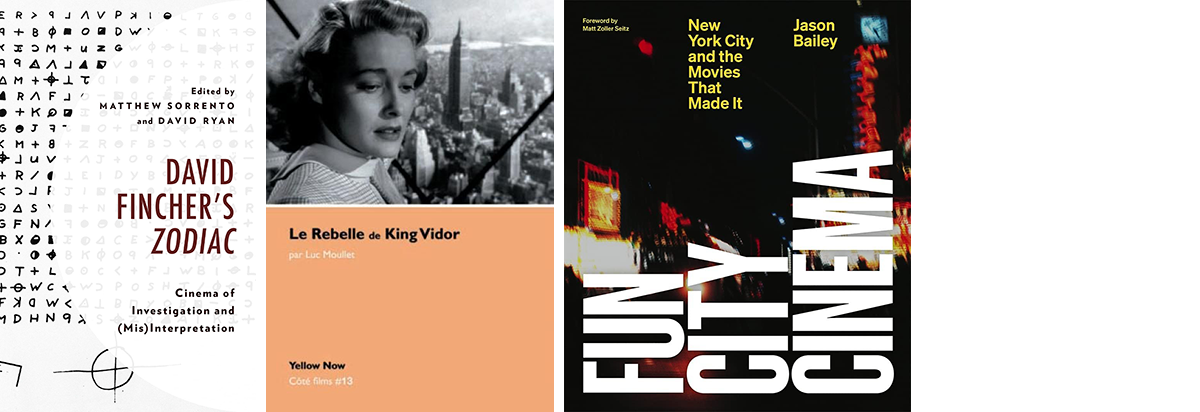
Out with Fairleigh Dickinson University Press this month, David Fincher's Zodiac: Cinema of Investigation and (Mis)Interpretation is the first book-length work of criticism dedicated to the 2007 film. Section One focuses on early influences, while the second part analyzes the film’s unique treatment of narrative. The collection closes with a section on game theory and the sound of the film.
On December 17, Srikanth Srinivasan finished his English translation of Luc Moullet’s monograph on The Fountainhead (1948), Le Rebelle de King Vidor (Yellow Now, 2009). You can read his work in five parts on his website, The Seventh Art. It’s a generous continuation of his big Luc Moullet Translation Project, following his translations of the Moullet collections Piges Choisies, Politique des acteurs, Fritz Lang and Cecil B. DeMille: L’Empereur du mauve. The Fountainhead isn’t part of the ten films across ten decades in Fun City Cinema: New York City and the Movies That Made It. Published by Abrams, the book approaches the selected films as “accidental documentaries” of the city, and includes historical photographs, production materials, as well as original interviews with Larry Clark, Walter Hill and Martin Scorsese, among others. The silly title might be misleading, rock and cultural critic Greil Marcus (Lipstick Traces: A Secret History of the 20th Century) calls it a “treasure”.
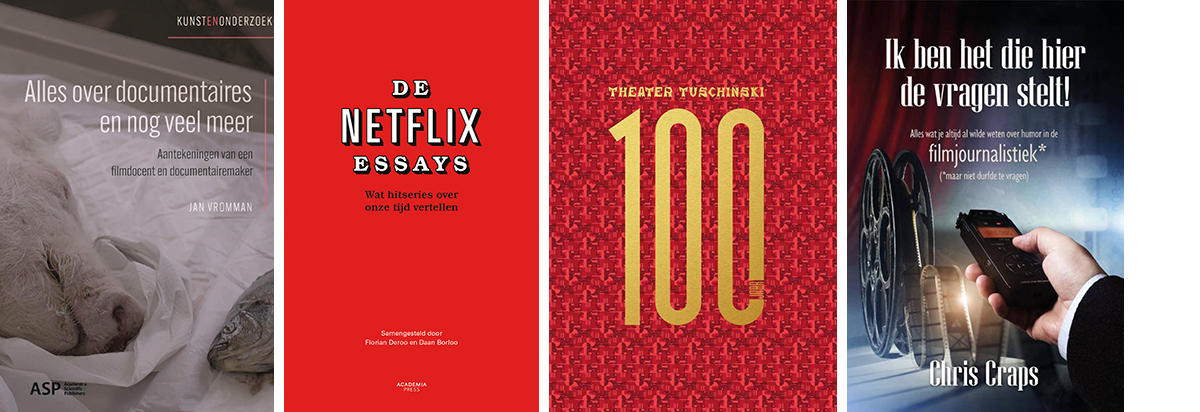
In the last few months, a number of Dutch-language film books have also been published in the Low Countries. Following his film De geschiedenis van het varken (in ons) (2017), which formed the first artistic part of his PhD in the Arts, Belgian filmmaker Jan Vromman now published its theoretical component: Alles over documentaires en nog veel meer: Aantekeningen van een filmdocent en documentairemaker. Drawing on his experience as a maker and teacher, Vromman addresses the documentary film from different angles in his notes and covers questions ranging from “the uniqueness of beauty” to the market or the ethical treatment of reality and people.
De Netflix Essays collects, as the name suggests, essays on Netflix. Edited by Florian Deroo and Daan Borloo, the book brings together texts by five young Belgian essayists. Dominique De Groen, Mats Vandroogenbroeck, Zeynep Kubat and the editors themselves write about seven series produced by the company.
In the Netherlands, the 100th anniversary of the Amsterdam film palace Tuschinski is celebrated with the publication of the coffee-table book Theater Tuschinski 100 jaar, offering photos and an extensive history of the cinema founded by the Polish Jew Abraham Tuschinski, who arrived in Rotterdam in 1904 to build his cinema empire. It might be a nice companion piece to Le Saint-André-des-Arts about the eponymous Paris cinema, which was simultaneously published by L’Harmattan last October. Finally, Chris Craps collected memories and anecdotes of 30 years of work as a film journalist (Gazet van Antwerpen, Het Belang van Limburg) in Ik ben het die hier de vragen stelt!
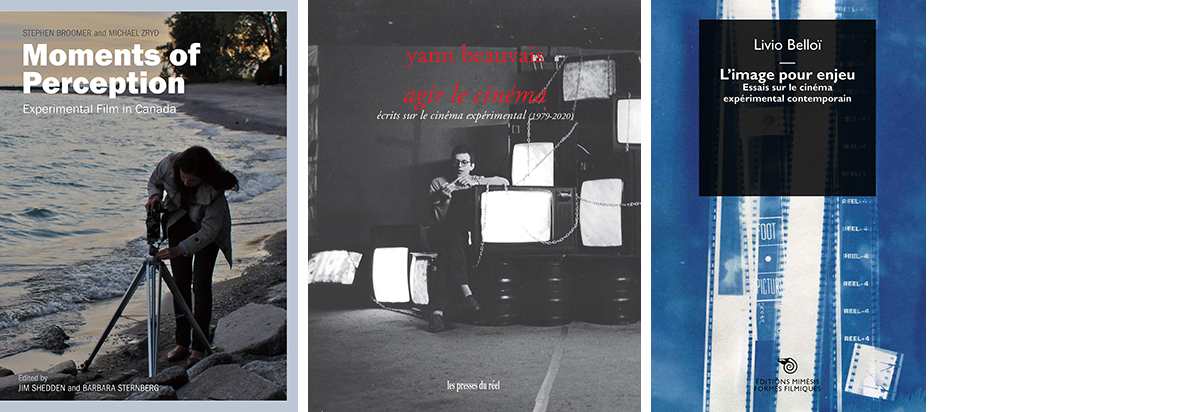
This winter’s selection contains several titles on the experimental cinema tradition, including two collections of interviews with avant-garde filmmakers. Moments of Perception: Experimental Film in Canada for the first time maps experimental filmmaking in Canada from the 1950s to the present day. Published by Goose Lane Editions and edited by Jim Shedden and Barbara Sternberg, the volume contains contributions on prominent figures such as Michael Snow, Joyce Wieland and Mike Hoolboom. Hoolboom is also featured in Agir le cinéma – Écrits sur le cinéma expérimental (1979-2020), an anthology of Yann Beauvais’s texts on experimental film and cinema which will appear at Les presses du réel during the first quarter of 2022. Another collection of essays on contemporary experimental cinema has recently been published by Livio Belloï, researcher at the University of Liège. Alongside the work of emerging artists, Belloï revisits the oeuvre of established filmmakers such as Bill Morrison and Ken Jacobs.
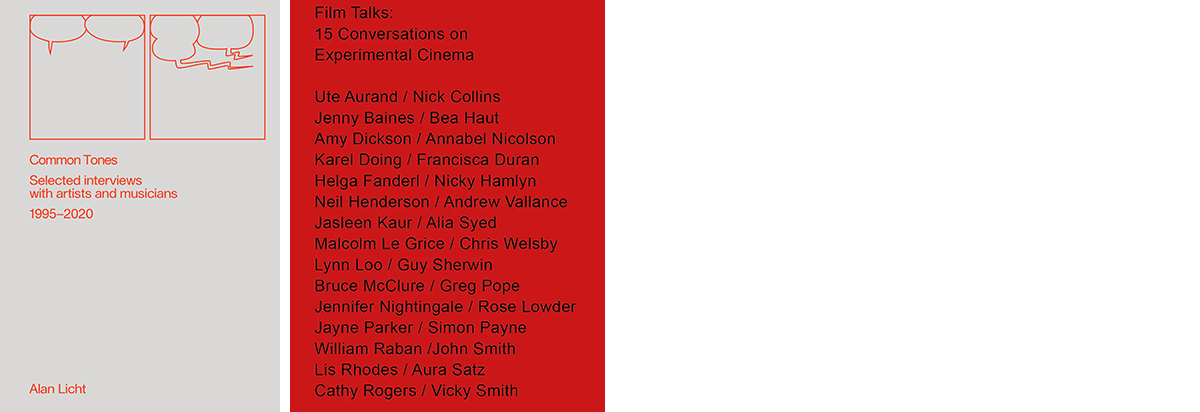
Ken Jacobs is also among the artists interviewed by writer, musician, and curator Alan Licht in Common Tones: Selected Interviews with Artists and Musicians 1995–2020, out with Blank Forms since August. Other filmmakers included in the volume are Tony Conrad, Kelly Reichardt and Michael Snow. The second book of interviews, Film Talks: 15 Conversations on Experimental Cinema, is published by Contact and presents a collection of dialogues between filmmakers. Amongst them is Nicky Hamlyn, member of the Brussels-based platform Cinéma Parenthèse, who discusses the ‘pro-filmic’ together with Helga Fanderl. The impressive line-up also includes Ute Aurand, Alia Syed, Malcolm Le Grice, Guy Sherwin, Bruce McClure, Rose Lowder, John Smith and Lis Rhodes, among others.
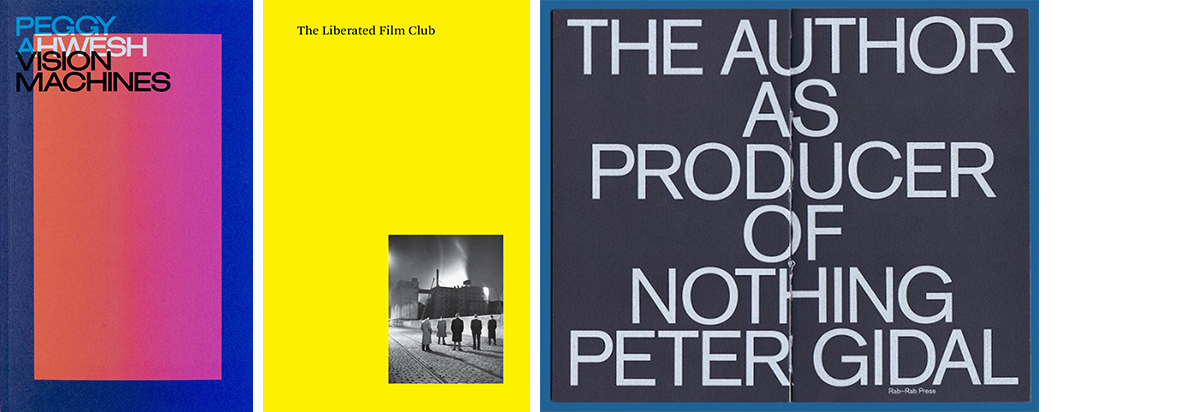
Forthcoming with Mousse Publishing in the first quarter of 2022, Peggy Awesh: Vision Machines is a collection of texts on American experimental filmmaker and video artist Peggy Awish that explores her heterogeneous oeuvre in relation to themes such as cultural identity, gender and popular culture. Among the contributors you find Erika Balsom and Elena Gorfinkel. Gorfinkel is also part of The Liberated Film Club, a collection of transcriptions, special commissions and texts anchored in a series of screenings by the Club held at London’s Close-Up Film Centre. The gist of these screenings was that neither the audience nor the invited guest introducer would have any idea what film would be shown, and this anonymised arrangement would invite broad and antagonistic perambulation on the what, the why and the how of film; on the act(s) of showing, sharing and seeing. Among these guests whose works and texts are in the book, you find Chris Petit, Ben Rivers, John Akomfrah, Sean Price Williams and Laura Mulvey, among many others. Nicole Brenez said of the curator of the short-lived Liberated Film Club (2016-2020): “There are more and more curators of experimental cinema, which is great; but unfortunately still few experimental curators. Stanley Schtinter offers us a fascinating and liberating example.” This is the second publication from the exciting and adventurous Tenement Press, an occasional publisher of experimental, esoteric, accidental and interdisciplinary literatures, founded in 2020.
Lastly, we’re treated to a whole other type of statement, or maybe not, in the form of the first-ever publication of a lost essay from 1978 by the renowned filmmaker and film theorist Peter Gidal, The Author As Producer Of Nothing. Out with Rab-Rab Press since October, the text deals with the limits of language and representation in experimental filmmaking and writing, and is provided with a new introduction.
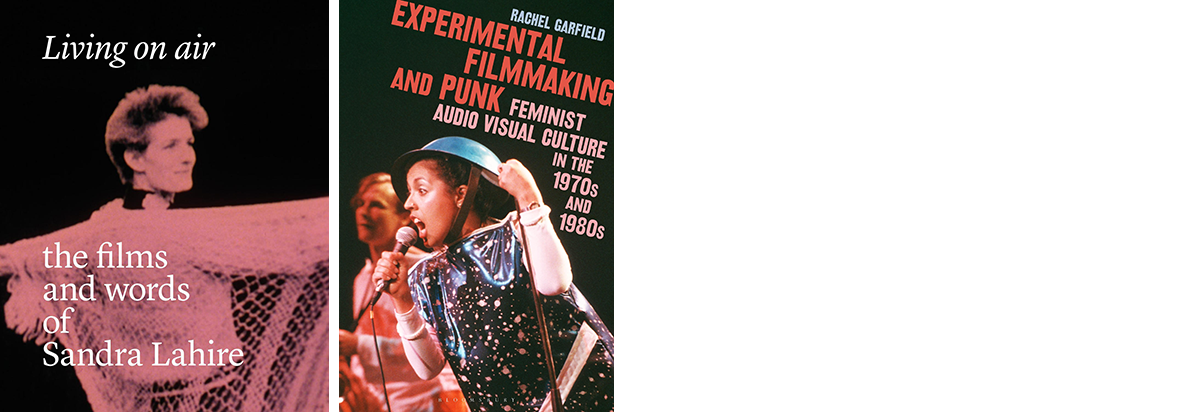
Compiled on the occasion of a Sandra Lahire retrospective at Courtisane festival 2021, Living on air: The films and words of Sandra Lahire is the first monograph dedicated to the work of the British, Jewish, lesbian filmmaker (1950-2001) who was a central member of the feminist and experimental filmmaking community in London in Thatcher’s 1980s and the 1990s. Edited by María Palacios Cruz and Charlotte Proctor, this cahier brings together new and existing texts on Lahire as well as writing by herself, with contributions by Lis Rhodes, Selina Robertson & Ricardo Matos Cabo (with So Mayer) and Ana Vaz, among others. You can browse through the online edition or order a physical copy at Courtisane’s brand-new online bookshop!
Living on Air has been developed in collaboration with and as a research project at the Elías Querejeta Zine Eskola (EQZE) in San Sebastian. What is more, news is out that EQZE will also publish Adrian Martin’s new book, Filmmakers Thinking, in June 2022. The 320-page English-language publication will have a limited run of around 100 printed copies, but it will also be available open access.
Back to Sandra Lahire; she is also part of Experimental Filmmaking and Punk Feminist Audio Visual Culture in the 1970s and 1980s. Published by Bloomsbury last November, this book looks at film and video artists such as Lahire, Vivienne Dick, Betzy Bromberg, Ruth Novaczek, Sadie Benning, Leslie Thornton, Abigail Child and Anne Robinson, who offered a powerful, deliberately awkward alternative to hegemonic conformist femininity, creating a new “Punk audio visual aesthetic”. “Rachel Garfield writes a new lineage of experimental film, convincingly rendering the filmmakers’ shared stance of ‘oppositional modernism’”, Abigail Child herself remarked.
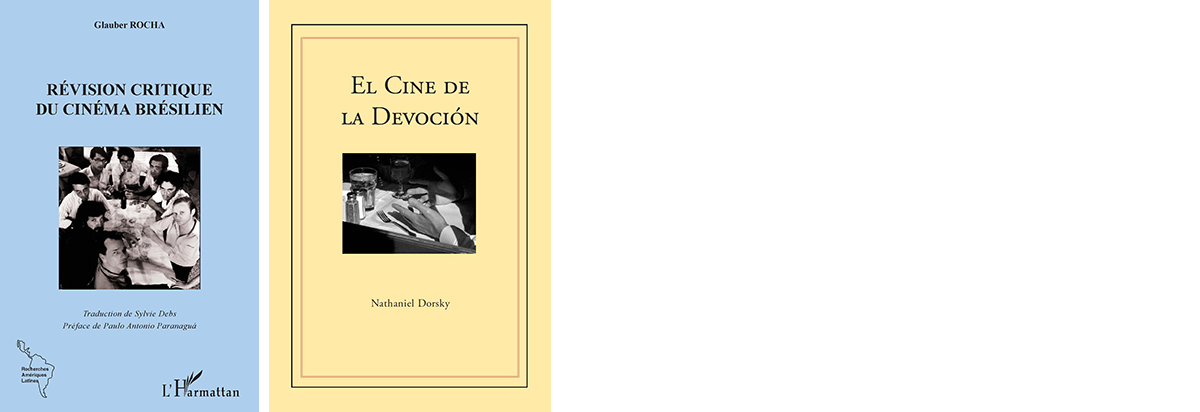
While all of the publications included until now more or less revolve around certain filmmakers, the next section deals more explicitly with criticism. Firstly, two beautiful filmmaker manifestos will be able to reach a wider readership now that they are (re-)appearing in translation. Glauber Rocha’s La Révision critique du cinéma brésilien is translated into French for the first time by Sylvie Debs. Originally published in Portuguese in 1963, this fundamental manifesto was already available in Spanish and English. In Spain, the film magazine Lumière will reissue their sold-out Spanish translation of Nathaniel Dorsky’s 2003 Devotional Cinema in its third revised edition of 2014, and launch it in the second week of January, accompanied by film programs of the work of Dorsky and Jerome Hiler.

Two new collections deal with the intricate relationship between cinema and photography. Film historian and theorist Philippe Dubois, one of the foremost figures in these debates, revisits the question in Photographie & Cinéma: De la difference à l’indistinction, published by Editions Mimésis. Gathering years of research in a total of fifteen texts, Dubois develops a perspective that goes beyond the archaic opposition of stillness and movement. Rather than adopting a medium specific approach that focuses on the differences between cinema and photography, his writings explore their close entanglement. Interested in those instances that blur the boundary between the two media, Dubois looks at the work of Chris Marker, Eric Rondepierre, Victor Burgin, David Claerbout and Paolo Gioli, amongst others. Film critic and former director of the collection series of Cahiers du cinéma, Alain Bergala, also for the first time collected his texts on photography and its relation to film. Published by Éditions Xavier Barral, Écrits sur l’image brings together a total of 27 texts published between 1976 and 2020.
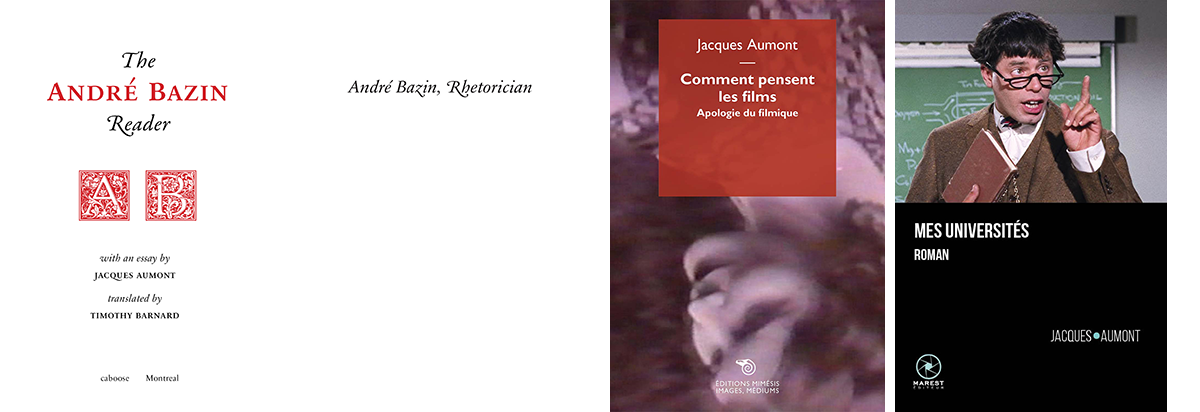
This month the Canadian publishing house Caboose starts shipping the extensive The André Bazin Reader, which features an expanded translation and annotation by Timothy Barnard of Bazin’s Qu’est-ce que le cinéma (1958-1962) and other writings. A considerable expansion of their André Bazin: Selected Writings (2018 and 2020), this almost 700-page sewn hardcover cloth-bound edition contains 44 texts by Bazin, several of which have never before been translated into English. And Caboose Books will bring us more of André Bazin in the near future, as another two-volume publication titled André Bazin, Rhetorician: Epigrams 1942-1958, is currently in preparation for a release, “coming soon” in 2022. Organised chronologically by year, It hosts a collection of over 2000 pithy epigrams “which reveal that deep within this massive body of work, sometimes in the seemingly unlikeliest of places, lies a hitherto unknown Bazin”.
Emeritus film professor and theoretician, Jacques Aumont, has written the introductory essay for both Bazin publications – the first one is available to read online – and has already published two new books of his own. Comment pensent les films – Apologie du filmique, which appeared last October with Éditions Mimésis, explores the way films “think” in their own right and produce new meanings through their play on the properties of moving images. Forthcoming in January, the second publication – a self-proclaimed oddity in his oeuvre – is a first-time novel or book of memoirs titled Mes universités, “a life story that doesn’t shy away from flirting with storytelling”.
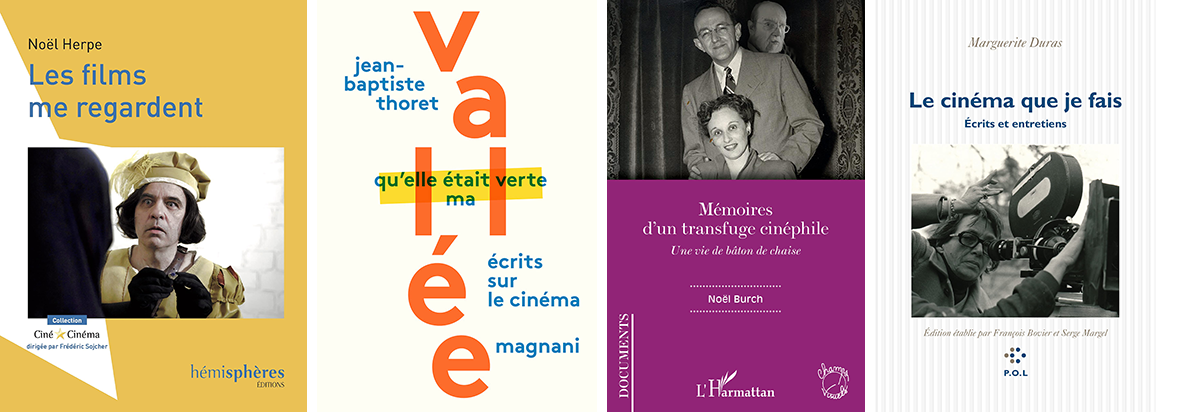
Jacques Aumont is but one of a rather large group of notable French critics and theorists who all suddenly seem to start looking back. Noël Herpe, well-known for co-authoring the 2014 Éric Rohmer biography, wrote Les films me regardent. Twelve years after Journal d’un cinéphile (Aléas, 2009) in which he gathered a certain number of his critical texts, Herpe now wanted to trace an evolution. Published with Hémisphères Éditions last September, this new volume includes writings of cinephilia pure et dure, rooted in a persistent love for French cinema, beyond chapel quarrels and Cahiers-Positif feuds. “From Bresson to Becker, from Rohmer to Assayas, I try to make the films dialogue with each other, to create links. I explore these connections more and more through autobiography. The central part of this book is titled ‘Before the images’ (‘Avant les images’) and it goes back to the source of my desire for cinema. What makes an image crystallize or fall back into darkness? What does cinephilia tell us about the work of memory? What do films find in us, in me? These are some of the questions that I raise, without wanting to elucidate too much of their mystery.”
In the wake of his recent Michael Mann book, critic Jean-Baptiste Thoret already comes with a new publication at Magnani Éditeur in January. In Qu'elle était verte ma vallée, he collects a sum of selected pieces, writings, essays, articles, chronicles, published from his beginnings until today on paper or on video. This 500-page companion offers a summation of the singular, profound and generous thinking of Thoret on cinema.
The French-American filmmaker, theorist and critic, Noël Burch, who has been living in France since 1951, also published his memoirs earlier this year. Out with L’Harmattan, Mémoires d’un transfuge cinéphile: Une vie de bâton de chaise talks, among other things, about his evolution from a ‘formalist’ conception of the medium to one he calls ‘contenuiste’ (content-oriented) – a choice not appreciated by his old friends at Cahiers, hence the ‘transfuge’ or ‘detractor’ as the main title. In the fall issue of Cinema Scope, Jonathan Rosenbaum juxtaposed Burch’s memoirs with the recent ones of Luc Moullet and wondered if French cinephilia is alive or dead. “You could arrive at opposite conclusions by reading or thumbing through the [respective volumes],” with Burch’s book indicating the fatal direction, at least for Rosenbaum. “Burch’s less jokey recollections focus not so much on his work as a writer or filmmaker as on his sexual relationships, combined with his proud scorecard as an alleged radical feminist and anti-bourgeois elitist-turned-populist.”
Another collection gathers for the first time the writings of Marguerite Duras concerning her own films, her practice as a filmmaker, as well as the most significant interviews she has given on this subject. Published by Éditions P.O.L last October, Marguerite Duras – Le cinéma que je fais: Écrits et entretiens is organized by films and includes for each film most of the texts she wrote in order to present her work to the public, to critics and sometimes to the actors themselves. Many of the texts in this almost 550 page-volume are unpublished, others had remained difficult to access. Some were published in press kits, newspapers and trade magazines when the films were released, others have been republished in collective works.

Written a few months before his death in February this year, À la vie ! is the last book by another French screenwriter, playwright and author, Jean-Claude Carrière. Published by Éditions Odile Jacob, it became a hopeful ode to life and a questioning of the world to come by a man who is about to leave it. Carrière co-wrote the last three films of Philippe Garrel, which were all shot by cameraman Renato Berta. This Swiss director of photography now also published his memoirs, Photogrammes, a retrospect on a life lived in the land of cinema. The opérateur, who worked on almost 120 films for directors such as Godard, Rivette, Rohmer and Manoel de Oliveira, recounts his life story, from the moment he founded a film club in high school to his conversations with Sartre and De Beauvoir. Renato Berta is not included in Conversations with Contemporary Cinematographers: The Eye Behind the Lens, but in the book Jacqueline B. Frost interviews a wide array of other cinematographers on their craft. Published by Routledge, the collection includes conversations with Edward Lachman, Rodrigo Prieto, Harris Savides, Dante Spinotti, and others.
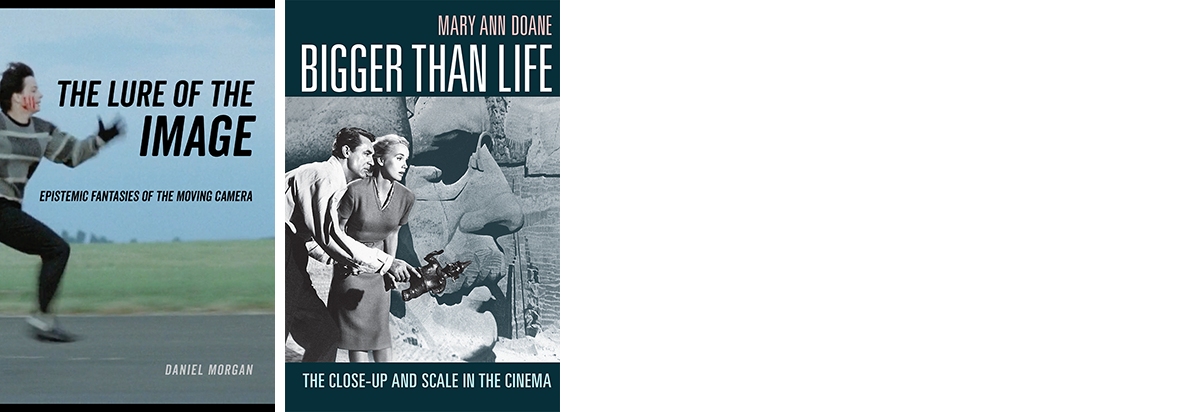
Camera movement is also the close object of study in another new publication, The Lure of the Image: Epistemic Fantasies of the Moving Camera. Out with University of California Press, the book “exposes the persistent fantasy that we move with the camera within the world of the film and examines the ways that filmmakers have exploited this fantasy.” Daniel Morgan, author of Late Godard and the Possibilities of Cinema (2012), reflects on the political and ethical stakes entailed by how the camera moves in films by Fritz Lang, Guru Dutt, Max Ophuls, Terrence Malick and in contemporary digital technologies.
Another study on a different aspect of ‘the lure of the image’ is Mary Ann Doane’s new book on the close-up and scale in cinema. Forthcoming in February at Duke University Press, Bigger Than Life: The Close-Up and Scale in the Cinema is praised by film scholar Tom Gunning as “a brilliant probing of cinematic space, matching her earlier, masterful treatment of cinematic time [The Emergence of Cinematic Time, 2002]. Mary Ann Doane explores cinema’s dynamic use of scale, from the magnification of the face in close-up to new screen technologies ranging from the iPhone to IMAX.” The substantial introduction to the book is available to download for free.

We’re closing with our regular section on newly-founded film magazines. Unfortunately, this winter we also have to bid farewell to the French film magazine Trafic, whose last issue, the 120th, has been printed this December. Meanwhile, Emmanuel Burdeau, former editor-in-chief of Cahiers du cinéma, is preparing a highly anticipated biography of Trafic’s co-founder, Serge Daney, that will be published by Éditions La Découverte. Only in our last but one book note, we reported about the launch of the new Flemish film quarterly in print, Fantômas. This month, news also hit that five months and one issue later the magazine will no longer be granted state funding… Nevertheless, Fantômas has decided to continue.

Despite these bad tidings and the loss of Trafic, new film magazines keep making their first appearances. Last October, MUBI launched their brand new, print-only Notebook magazine. Issue 0: For The Cinema To Come has already sold out, but you can sign up to hear about the future issues. The 132-page pilot issue included a personal journey through images and text by Apichatpong Weerasethakul, and translations of writings by Yasujiro Ozu, among others. Also celebrating its first print issue is the Romanian-language magazine Films in Frame. Films in Frame was already an online, bilingual (RO-EN) magazine, featuring critics such as Flavia Dima, Călin Boto and Victor Morozov. In the Mood Magazine: A journal about the things we like to watch already presented a second issue this November, but we missed to announce the launch of this new free online magazine last June. “In The Mood asks: what are your viewing habits, highs, and hang-ups? In other words, why do you look away and then look again? Why are you so obsessed with the exact shade of pink of Suki’s car in 2 Fast 2 Furious? Or the look on Marnie’s face after she’s fired the shotgun?” They also run a Film Recommendation Generator with a short personal text on each entry, e.g. Will Sloan on Pasolini’s The Gospel According to St. Matthew (1964) if you select ‘Neutral’ and then ‘Skeptical’.
Let’s conclude with the film book-related news that Nick Pinkerton and Matt Folden have been appointed as the new managers and curators of the (physical) Metrograph Bookstore in New York, while film programmer Thomas Beard has opened a used bookstore – called Monday Night Books after its opening hours – in one of the rooms behind Light Industry as of December 13. Pinkerton & Folden talk us through their plans on Metrograph’s website. In the meantime, Nick Pinkerton is working on his own Jean Eustache book to be released in 2022.

